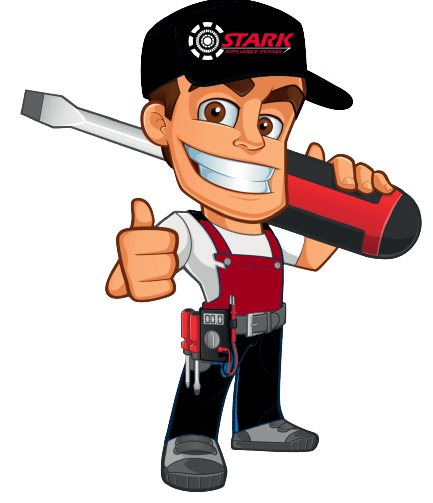Refrigerator Not Cooling?
Food spoiling refrigerator not cold enough?
Looking For Refrigerator Repair Expert Near Me? Call or Text Stark Appliance Repair Today, We'll make your refrigerator cold again!
Home > Residential Services > Kitchen Appliance Repair > Refrigerator Not Cold Enough
Why Is My Refrigerator Not Cooling?
My refrigerator is not cold enough
Insite to what the Cause is, "how to" Fixes, and When it's over
Refrigerators and freezers are designed to maintain a certain temperature. The FDA recommends that you keep your fridge at 40°F or lower, while the freezer should be set below 0 degrees Fahrenheit (or 32 Celsius).
Is your refrigerator not cooling or preserving your food? It might be cool but it's not cold. Our team at Stark Appliance repair can help you resolve your refrigerator cooling problem. We will walk you through the repair steps, as well as explain when you should step back and let a professional handle it.

Your refrigerator needs to keep food cold, period! You need an expert repair service so you don't end up throwing food away. Call us at (516) 234-5374 or schedule an appointment online.
If you're experiencing any issues with your refrigerator,
please do not hesitate to contact the qualified repair technicians at
Stark Appliance Repair today!
The best place to start checking
In some cases, the refrigerator is not broken, it's just that it isn’t cool or cold enough. These “simple guidelines" can help you from an awkward conversation with a repair technician and from any unnecessary service charges.

Quick Links
The refrigerator was not plugged in
- You might be surprised to know how many people don't stop to think of the obvious and are quick to jump to conclusions, never stopping to check if their fridge is even plugged in. By far this is the easiest thing to confirm.
The thermostat has been turned down
- Another easy thing to check and rule out is your thermostat. Check that the thermostat is set to the correct temperature. For a side-by-side freezer/refrigerators unit you'll typically find this information in the back. Over-under units can have their thermostat under the fridge.
The cold air is not circulating
- If boxes of food are blocking the vents, cold air can be obstructed from circulating through your fridge. Organize your fridge or clear out some of the food that could be blocking airflow and preventing your refrigerator from cooling.
The door isn’t closing properly
- Double check the doors and gaskets. Does the light in the fridge turn on and off when you close the door? If not, the door might not be functioning properly. Gaskets, the flexible elastic strip around the edges of the doors designed to seal the doors closed, can tear and leak warm or humid air into your fridge. If your gasket has torn, you should replace it and see if your fridge stays cooler.
Once you have looked through this list and if your refrigerator or freezer temperature still isn’t performing correctly, chances are you have a much more complicated issue. There are telltale signs that will indicate your warming fridge is more of an issue than perhaps having an overcrowded freezer - and our certified experts will tell you what to identify and where.
Refrigerator Problems and How to Repair Them
A warm refrigerator can have a few different reasons to contend with that could be causing your warm issue. When parts are misfunctioning it can be a process of elimination so to properly identify which part is causing the problem. Our certified appliance technicians have listed some common fridge and freezer issues, where they occur, and how to resolve them.
Refrigerator Compressor
Your refrigerator's compressor is the part that distributes refrigerant vapor into the coils you see on the outside of the fridge. The compressor acts in a manor of pushing and the pressure creates heat. This will then turn into a gas that will then cool and absorb heat from the freezer and or fridge. If the freezer fan is still operating and you notice the fridge is not getting cold, your compressor or possibly the compressor start relay could no longer be working.
Request For Service
Contact Us
We will get back to you as soon as possible.
Please try again later.


Slide title
“Mike promptly returned my call about fixing an old washer. He gave us great guidance that was honest and practical. We highly recommend him and will use him for all future appliance problems.
Sue M
Button
Slide title
“Mike was great. He explained exactly what was wrong with my refrigerator and fixed it very fast. He's honest and thorough - I highly recommend..”
Button
Slide title
“Very knowledgable and helpful. First called with a microwave issue and Mike knew the issue just from the call and save me from a unnecessary service cal $$$. Called him with fridge issue a few weeks after and he was quick, communicative and very professional. Fridge is working like new now and even fixed the water line which I was told was “not fixable” by another company. Thanks guys!
Button
Where is my refrigerator compressor?
- The compressor is located behind your fridge and at the bottom. It is a black, tank-like part. The compressor start relay is the part that feeds the cords into the compressor. You will need to pull your fridge away from the wall to access both parts. Make sure you unplug your refrigerator from its power source before you start.
Fixing a Refrigerator Compressor
- Replacing a refrigerator compressor start relay is easier and more affordable than buying a new compressor. That being said, trying a new relay with your compressor would at least let you know if a new compressor is necessary. Replacing a compressor means you’ll need to first remove it from what is referred to as a suction line and compressor discharge line followed by the electrical package. This means you'll need to sever the lines before loosening the bolts that hold the compressor in place. Remember that when you're connecting your new compressor you will need to be reconnect to the suction line, discharge line, and process line. These lines have welds that secure them. Make sure to switch over the crossover line prior to evacuating your new system.
Refrigerator Condenser Coils
Refrigerator condenser coils carry hot gas that the condenser produces up to the evaporator coils. Throughout this process the refrigerant cools and turns back into a liquid. When your condenser clogs the coils can suffer with poor circulation of the air, inhibiting your fridge’s ability to work properly and keep cool.
Where is my refrigerator condenser coil
- Condenser coils are found typically across the bottom or on the back. They connect from the compressor and the freezer.
How can I fix a refrigerator condenser coil
- with clogged coils, a cleaning really helps. First, unplug the refrigerator, then remove what is referred to as the "toe grill". With a coil brush, push the tool into the condenser coils and knock off the dust that has collected there. Then reconnect the refrigerator's toe grill.
Refrigerator Condenser Fan
The condenser fan cools the compressor and condenser coils as they work. The fan should run when the compressor is running. If you notice the condenser fan is not working, check the refrigerator’s thermostat as the temperature can rise causing the compressor to overheat.
Where Is my refrigerator condenser fan?
- The condenser fan is located in the bottom cabinet by the compressor and the condenser coils. It is important to note that refrigerators with condenser coils on the back will not have a fan.
How to fix my refrigerator condenser fan
- Confirm the condenser fan is working and nothing is blocking it. Dust as well as other objects can interfere with the condenser fan blades spinning. Once you know the fan is spinning okay and its ruled out as being the issue, the condenser fan motor may need to be replaced. You can find a replacement from the manufacturer. Once you have the motor's replacement, unfasten the mounting screws that hold the fan up and remove that assembly from the motor. Now after you've taken off the mounting of the old motor, you can install the new motor.
Refrigerator Evaporator Fan
The evaporator fan is the part of the fridge that blows the cool air you feel when you open the door. It pulls air across the evaporator coil, cooling it, and then pushes the air through the freezer and refrigerator. If the evaporator fan does not work or kick on when the compressor does, your unit will not be able to produce cool air.
How to find the refrigerator evaporator fan
- The evaporator fan is located behind your freezer wall. Empty your freezer of everything - shelving etc., before you proceed.
How to repair my refrigerator evaporator fan
- If the fan does not seem to be working, you might need to replace the fan motor. After removing the evaporator panel in the back of the freezer, locate the fan and remove the mounting clip, fan blade, and wire harness. Install the new motor into the wire harness and put the motor into the housing. Insert the fan blades completely and reapply the mounting clip. Reattach the evaporator panel and put back the shelving.
Refrigerator Air Damper
A refrigerator air damper controls how much cold air is released from the freezer to the fridge. If the air damper can’t close or can’t open, it can impact the temperature of the fridge while the freezer stays the right temperature. When the air damper can’t open, cold air cannot travel from the freezer to the fridge compartment, making it warmer.
Where is your refrigerator air damper
- The refrigerator air damper is located between the fresh food compartment and the freezer in your refrigerator. On a side-by-side refrigerator, the air damper should be located in the upper left corner of the fridge.
How to repair refrigerator air damper:
- Removing the air damper means removing any screws holding the conduit cover or damper cover into place, you'll need to remove the covers. Notice the thermostat sensor near the damper, remove it. If you have an Icemaker in your freezer, please remove the tray. There will be a motor, which can be unscrewed and unplugged to move the compartment out of the way. Unscrew the rear duct panel release the tabs holding the air damper in place. Remove the old one and install the new air damper, replacing all the compartments you removed in the process.
Now that you've exhausted your options
If you are struggling to diagnose the problem or don’t have experience replacing and repairing mechanical parts, there is no shame in calling a professional to handle it. Kitchen appliances can be complicated and we definitely don’t recommend you take your refrigerator apart if you don’t know what you are doing. Not only could you damage your expensive appliance further, but it can be incredibly dangerous. At
Stark Appliance Repair, our team of repair experts understands how to quickly and effectively repair your unit. When in need, call Stark! We can help you out with a refrigerator not cooling, or any other issues you're facing.
Saying Goodbye to Your Unit
It happens, refrigerators expire, so when it's past the point of no return it will actually be more cost-effective to purchase a new refrigerator instead of repairing your current one. So how can you tell when your refrigerator needs to go?
Most consumer reports advise that the age of your unit and the cost of your repair service are the best indications for when you should replace your refrigerator. Refrigerators need the first repair within:
- 7 years for bottom-freezers with additional repairs in the future
- 5 years for side-by-side fridge/freezers with additional repairs in the future
- 3 years for top-freezers with additional repairs between 3-6 years, and replacement after 7 years

Is your refrigerator on the fritz? Call Stark Appliance Repair today at (516) 234-5374 to learn about our home appliance repair services, or schedule service right here!
Certified Technicians with Years of Experience and extensive Brand Knowledge
Schedule a Convenient Appointment for Your Appliance Service
Upfront and Honest Pricing. You'll be made aware of the cost prior to all service and repairs
We advise our clients, sometimes replacing an appliance is your best option.

Reasons Why Long Island NY Residents and Businesses Choose Stark Appliance Repair...
Stark Appliance Repair
We bring pride and passion to every project that we undertake, with a professional team of designers, project managers and tradespeople.
We Repair Nassau County Long Island NY

